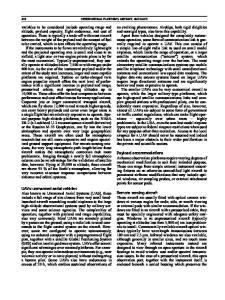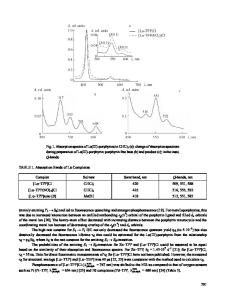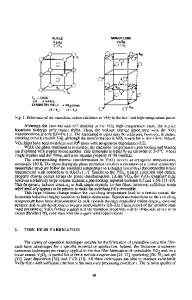Optical Absorption, Luminescence, and Redox Switching Properties of Polyphenylene Derivatives
- PDF / 309,128 Bytes
- 5 Pages / 414.72 x 648 pts Page_size
- 60 Downloads / 311 Views
ABSTRACT A series of polyphenylene derivative polymers with a variety of heterocyclic units along the main chain, and various pendant groups, have been synthesized and their optoelectrochemical properties examined. Polyphenylenes containing electronically isolated emitter centers have optical absorption and luminescence characteristics which are a function of the length of the conjugated unit. A water soluble electroactive rigid-rod poly(p-phenylene), specifically poly[2,5-bis(propoxy-3-sulfonate)-1,4-phenylene-at- 1,4-phenylenel, has been prepared. Solution cast films of this polymer exhibit optical evidence for bipolarons via both p-type and ntype electrochemical doping. Further poly(p-phenylene) (PPP) derivatives are being pursued, including PPP's bearing pendant donor molecules for charge transfer complex formation. A series of polymers containing alternating p-phenylene units with bithienylene and bifuranylene units, specifically poly[1,4-bis(2-heterocycle)-2,5-disubstituted- 1,4-phenylenes], have been synthesized with both alkyl and alkoxy pendant groups. Steric interactions disrupt the ability of the redox doped polymers to attain planarity, strongly affecting the polymer's oxidation potentials and DC conductivities. The substituent length has little effect on the electronic properties of the polymer, but greatly affects the polymer's solubility and transport properties during redox switching.
INTRODUCTION Polyphenylenes have attracted a great amount of attention due to the fully aromatic character of the backbone, high thermal stability of the neutral polymers, and ability of the nt system to be redox doped to high levels of electrical conductivity. As a redox dopable, electrically conductive and electroactive polymer, early research on poly(p-phenylene) (PPP) served as an impetus for the study of a broad variety of aromatic polymers. I The recent discovery of blue-green light emission during electroluminescence of PPP suggests these polymers may prove useful in optoelectronic applications. 2 The direct syntheses of polyphenylenes utilizing unsubstituted monomers leads to highly insoluble materials, generally in the form of powders, which have low molecular weights. In order to increase the degree of polymerization, induce solubility, and obtain polyphenylenes with well defined structures, cross coupling polymerization of aryl boronic acids with aryl bromides was used for the synthesis of a number of alkyl substituted PPP's with degrees of polymerization of approximately 30 to 50.3-5 Suzuki coupling 6 polymerizations have also been used to produce water soluble, carboxy substituted PPP's with an average of one carboxylic acid group for every 191 Mat. Res. Soc. Symp. Proc. Vol. 328. ©1994 Materials Research Society
two phenylene rings.7 -9 In addition to the direct syntheses of PPP's, soluble precursor routes have been developed for their preparation. 10,11 While the polymers formed using this method have high molecular weights and form excellent films, the methodology used makes synthesis of a large vari
Data Loading...









